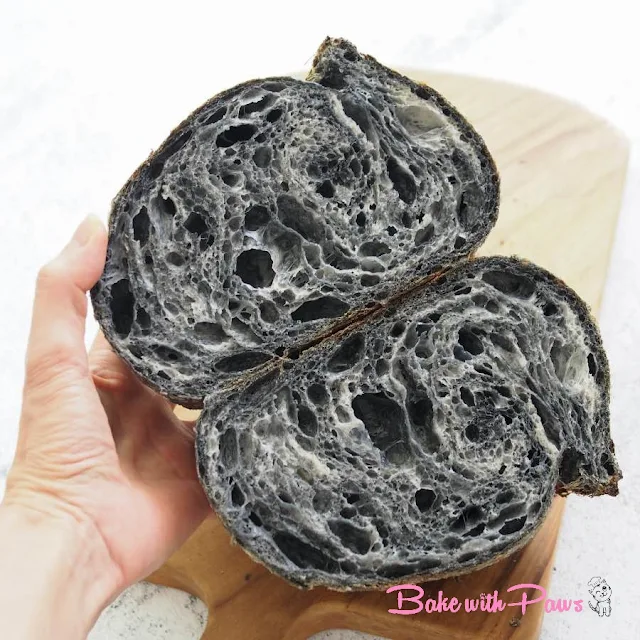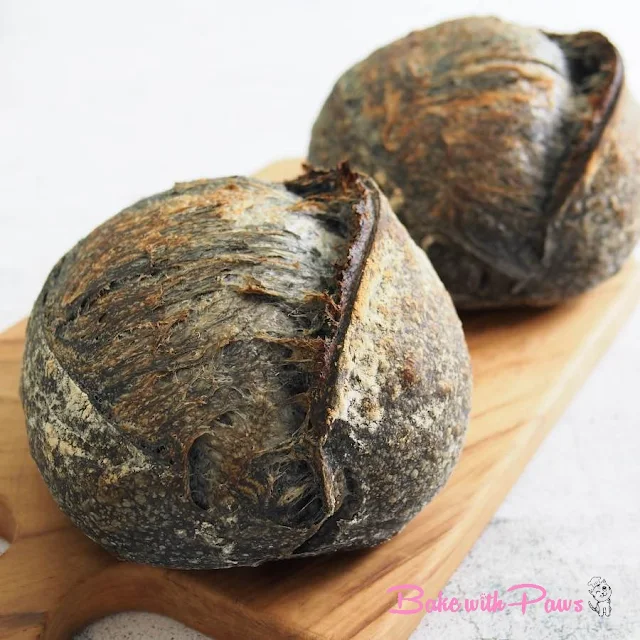Breads (Sourdough) - Open Crumb
Marbled Charcoal Sourdough Bread
July 20, 2023
| Recipe by Bake with Paws
Scroll to the bottom of the page for "PRINT RECIPE" ⬇
This is my second attempt at making Marbled Charcoal Sourdough Bread. I think I got the ratio right this time and the marbling result is more distinct. I used 60% plain dough and 40% charcoal dough. If you prefer a lighter shade, then go for 70% plain dough and 30% charcoal dough.
Charcoal doesn't give any flavour to the bread but only adds colour.
Disclaimer: If you are under medication, it is advisable to consult with your doctor or healthcare professional before consumption as charcoal may interact with certain medications. Please do your own research.
If you have any questions regarding this recipe or any other post, please leave me a comment in the “LEAVE A COMMENT” link and I will reply you as soon as possible. Do tag me on Instagram @Bakewithpaws if you attempt on this recipe.
How To Make Marbled Charcoal Sourdough Bread
Yields: 2 Batards
INGREDIENTS:
Plain Dough:
324g bread flour (I used Japanese high gluten flour - around 12% protein) - 90%
36 whole wheat flour - 10%
276g water - 78.78% final hydration *
7.2g salt - 2%
72g active sourdough starter/levain (100% hydration) – 20%
Charcoal Dough:
216g bread flour (I used Japanese high gluten flour - around 12% protein) - 90%
24 whole wheat flour - 10%
3g activated charcoal powder
184g water - 78.78% final hydration *
4.8g salt - 2%
48g active sourdough starter/levain (100% hydration) – 20%
- Please refresh your starter several times before baking day in order to get a better result if you do not feed your starter daily or regularly.
- Please reserve some liquid and not add it all in one go as each flour absorbs water and hydrates differently.
Ambient temperature after adding in levain: 26C
Total bulk fermentation: Around 6 hours
METHOD:
- Feed starter :-
- Feed ratio of 1:1:1, keep at room temperature (28C – 30C) and wait until tripled, around 4 – 5 hours.
- Please feed your starter at the ratio that fit your schedule as long as the starter is at its peak when use. Please click here for here "Sourdough Starter Recipe"
- Mix the dough :-
- Mix each dough individually.
- Dissolve levain and water in a bowl of stand mixer. Add in flours and salt. Mix with paddle attachment for about 3 - 4 minutes at speed 2 (KA mixer) and slowly turn to speed 4 or until the dough turns smooth, comes together and away from the sides of the bowl.
- Divide into 2 equal portions. Transfer dough to bowls and round up. Cover and rest for 30 - 45 minutes at room temperature around 26C.
- Lamination -
- Laminate individually.
- Lightly mist the counter top with water and wet your hand. Transfer plain dough onto the counter top. Pull from centre out to form a rectangle shape.
- Carefully stretch the charcoal dough and place on top of the plain dough.
- Pick up one edge and fold into the center. Pick up other edge and fold into the center over first section. Fold the top down half way. Fold the bottom up.
- Put dough in a new dish (square pyrex dish). The reason to use a square dish is because it is easier to judge how much the dough has spread. Cover and rest for about 45 - 60 minutes or until dough spreads.
- Coil Folds:-
- Coil Fold 1- At this stage, the dough is weak and extensible. Fold the dough in the dish. Cover and rest for about 60 - 90 minutes or until dough spreads.
- Coil Fold 2 - At this stage, the dough is quite strong and not so extensible and will be the last coil fold. However, if the dough is still quite extensible and spread a lot, then you will need one more coil fold. Fold the dough in the dish. Cover and rest for 90 - 120 minutes or until dough rise 50% in size since you added the levain.
- Shaping :-
- The dough had risen about 50% - 60% in size since adding the levain. The dough should look puffy. It should jiggling when you slightly shake it. This is the end of bulk fermentation. The total fermentation time for this bread is about 6 hours.
- Flour the counter top. Shape the dough. Brush the top of the dough with plain water and roll the dough (top) into a dish filled with sesame seeds then transfer to a slightly flour banneton with the seam side up.
- Proofing on the counter:-
- Proof at room temperature for 10 - 15 minutes. I skipped this as my dough had risen about 60% by the time I shaped.
- Retard:-
- Then retard overnight in the fridge (4C). This bread is about 18 hours in the fridge.
- Baking :-
- Preheat oven with the dutch oven (cast iron) at 250C (top & bottom heat) for at least 30 minutes before baking.
- Take bread dough out from the fridge, invert onto a parchment paper and scoring.(Slash the dough approximately 0.5 inches deep at 45-degree angle). Immediately transfer the dough with the parchment paper to your preheated dutch oven.
- Bake at 250C (top and bottom heat) with cover on for 25 minutes. Remove the cover and lower the temperature to 220C (top & bottom heat), continue bake for another 10 minutes.
- Remove bread from oven and dutch oven. Let it cool on rack completely before slicing.
Mix The Dough
Lamination
Coil Fold 1
Coil Fold 2
Shaping
Baking & Scoring
GENERAL NOTES
SOURDOUGH STARTER
Please click this link for "How To Make Sourdough Starter" and "Sourdough Maintenance"
A healthy starter is very crucial as advised by Baking with Gina. It is advisable to feed your starter regularly if you want your bread to rise nicely and to use the starter (levain) at its peak. A starter that is fed regularly will be more active in general. If the mother starter is not strong, the bread dough will not rise a lot even though the starter is used at its peak.
HYDRATION
The liquid measurement given is also a guide. It is advisable to always reserve some liquid and not add it all in one go. This would give you the opportunity to adjust if necessary. If dough is too dry, add the reserve liquid one tablespoon at a time until the right consistency. This is because each flour absorbs water and hydrates differently.
BULK FERMENTATION
Bulk fermentation starts when you add in levain to the dough and ends when the dough is ready for shaping.
TEMPERATURE DURING BULK FERMENTATION
Ambient temperature plays a very important part in sourdough baking. It will affect the dough temperature and eventually affect your fermentation time. The cooler ambient temperature will extend the fermentation time. The greater degree of proof, the stronger the dough will be as explained by Trevor J. Wilson.
The ambient temperature that worked for me is between 25C - 26C and bulk fermentation time is between 4.5 hours to 5.5 hours. At the end of bulk fermentation, my dough would have increased 50% in volume. The dough should look puffy. It should jiggling when you slightly shake it. This is the end of bulk fermentation.
But, my kitchen ambient temperature (without air-conditioner) was 29C - 30C. So, I have to bring down the temperature.
How to bring down ambient temperature?
- Air-conditioner room - Rest the dough in air-conditioner room during bulk fermentation. I used this option sometimes. I turned on my air-conditioner when I added in levain and try to maintain temperature between 25C - 26C.
- Home oven (that's turned off) - Place ice cooler packs inside along with an ambient temperature thermometer. Then place your dough during bulk fermentation in the oven. Keep an eye on that thermometer and try to keep between 25C - 26C.
DOUGH STRENGTH AND EXTENSIBILITY
Too strong (tension or elastic) dough will take a longer time to increase (proof) in volume. So too strong dough may not have good oven spring and open crumb. While too weak dough (extensibility) dough may not hold it shape and rise with good oven spring too.
So over-working the dough (too strong dough) or under-working (weak dough) may affect the crumb structure and oven spring.
The number of coil folds is not fixed and very much depends on the strength and extensibility of the dough.
As demonstrated in an experiment by Kristen (Full Proof Baking) the over-worked dough rose super tall but was smaller in overall size and had a more dense crumb while the control dough rose tall during the oven spring and had a better overall result.
How do we know when it is enough and no more coil folds are needed?
We usually do 3 coil folds for this method. However, if by the second coil fold the dough is strong with less extensibility as you lift up a part of the dough then it should be the last coil fold, or just do a half coil folds instead of full. The resistance of the dough to being folded should be an indication to refrain from folding further.
How do we know when to do the next coil fold or stretch & fold?
When the dough spreads. Please do not rely on the time given in the recipe as it is just a guideline. Please watch your dough and not the clock.
Labels:
Breads (Sourdough) - Open Crumb,




_Fotor.jpg)
_Fotor.jpg)
_Fotor.jpg)
_Fotor.jpg)
_Fotor.jpg)
Comments
Post a Comment